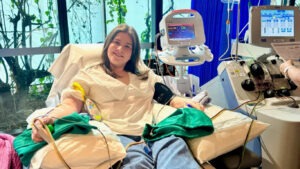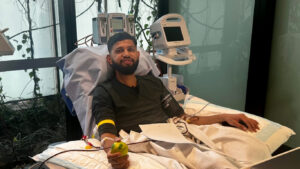Most people know about blood and organ donation. But ask around about stem cell donation and you’ll probably get blank looks. That needs to change.
For some people living with blood cancer or other serious blood disorders, a stem cell transplant can be their only hope. Yet most people still don’t know how donation works, who can do it, or how simple it is to sign up.
What is stem cell donation
Stem cell donation is when a healthy person donates their blood forming stem cells to someone whose own bone marrow no longer works properly. These healthy cells help the patient’s body start making blood again.
Doctors use stem cell transplants to treat blood cancers like leukaemia, lymphoma and myelodysplasia. It’s also used to treat some other blood diseases like thalassaemia and aplastic anaemia.
It’s one of the few treatments that can completely replace a damaged immune system and give someone another shot at life.
Why stem cell donation saves lives
Every year thousands of people are diagnosed with blood cancer. For some, chemotherapy and other treatments stop working.
There’s around a 25 percent chance that a patient’s brother or sister could be a match. For everyone else, a matching stem cell donor from a complete stranger could be their only hope.
That donor could be you.
Australian imports more than 85 percent of their stem cells from overseas. It’s a clear sign that not enough young and diverse people have joined the Aussie registry.
When more Aussie donors step up, patients have a better chance of finding a match faster without long waits or added risks.
How to become a stem cell donor
Joining Stem Cell Donors Australia, the Aussie registry, is really simple. It only takes about three or four minutes to sign up online, and a cheek swab kit arrives in the mail.
Swab your cheeks, post it back (try not to leave it on the kitchen counter for weeks), and within six weeks you’re on the list.
Why does it take six weeks? Once the swab kits are returned, they’re sent in batches to a specialist laboratory in Germany for tissue typing.
There’s a lot of work that happens behind the scenes to make sure your details are accurate in case you ever come up as a match.
How donating stem cells actually works

If you’re ever matched with someone, here’s what happens next.
About 90 percent of donations are done through the blood. In the four days leading up to donation, you’ll have small daily injections of a growth factor called G CSF. That helps your bone marrow release stem cells into your bloodstream.
On donation day, blood flows from one arm into a machine that separates out the stem cells and returns the rest of your blood through the other arm. It takes about four to five hours. Most donors scroll socials, listen to podcasts or watch Netflix while it happens.
Around ten percent of donations are done under general anaesthetic. Doctors collect stem cells directly from the bone marrow in the hip bone. It sounds a bit scary, but it’s over and done with in about 45 minutes. There’s no need for the daily jabs in the lead-up to donation day.
The doctors may have a preference, but you as the donor will always have the choice if you’d prefer to donate through the blood.
What are the side effects of donating stem cells
Like any medical process, there can be mild side effects, but most are short term and easy to manage.
If you are donating through the blood, you’ll have a small daily jab for four days before donation.
Some donors feel achy, tired or have mild bone pain while their body produces extra stem cells. This usually fades within a few days and can be eased with rest, paracetamol and staying hydrated.
On donation day, you may feel light-headed, have a few chills, and some people have a tingling sensation around the mouth. A temporary drop in calcium levels causes this tingling. It’s minor and very easily fixed. The donation team might give you a calcium or magnesium supplement, and it usually stops within minutes.
If you donate under general anaesthetic, you might have some tenderness or bruising where the marrow was collected.
This usually lasts for about a week, but it’s a small price to pay for potentially saving a life.
Rest assured, you’re cared for at every step of the way, from the moment you’re matched to the time you’re ready to go home.
Most donors say the process was much easier than they expected and that they’d do it again in a heartbeat!
Who can become a stem cell donor?
Thinking about joining? Here’s what you need to know. You can sign up if you:
- are aged 18 to 35
- are in good health
- have a green or blue Medicare card
You’ll stay on the registry until you turn 60. The registry focuses on younger donors because they give patients the best chance of survival and recovery, and a better quality of life after their transplant.
If you’re 36 or over, you might be wondering why you can’t join. It’s simply because outcomes are stronger when stem cells come from younger donors. Don’t worry, there’s still plenty of ways you can help.
You can spread the word to your family, friends and co-workers; donate to The TLR Foundation to help us recruit more young donors; or join us at one of our fundraising events like the City2Surf.
Every bit of support helps us give more people hope.
Why young and diverse stem cell donors are urgently needed
Every person who joins the registry could be someone’s only chance. But right now, there simply aren’t enough young and diverse donors.
Patients can only receive stem cells when they find a close genetic match.
That’s why we’re asking more young Australians from all backgrounds to sign up.
The more variety there is on the registry, the better the chance every patient has of finding their match.
Signing up doesn’t mean you’ll definitely be called. Most people never are.
But if your cells are the ones that can save someone’s life, that call will mean everything, for you and for them.
Why diversity matters in stem cell donation

When it comes to stem cell transplants, matching depends on DNA, which is linked to ancestry. That means patients are far more likely to find a match from someone with the same ethnic background or mix of backgrounds.
The challenge is that the current registry doesn’t yet reflect the full mix of cultures and communities that make up Australia. This means patients from Asian, Middle Eastern, African, Pacific Islander or mixed-heritage backgrounds often face the hardest search for a donor.
Every new person who joins helps close that gap, especially donors from under-represented communities. By signing up, you’re not just joining a list, you’re helping build a registry that reflects the real diversity of Australia and gives more people a fair chance at life.
Be a legend, save a life
Donating stem cells is one of the most powerful acts of kindness there is.
It’s safe, simple and it can mean the world to someone living with blood cancer.
If you’re aged 18 to 35, this is your chance to do something amazing.
Join the stem cell donor registry today.
References
- The TLR Foundation – Become a stem cell donor
- Stem Cell Donors Australia – Partners
- Cancer Australia – Stem Cell Transplant